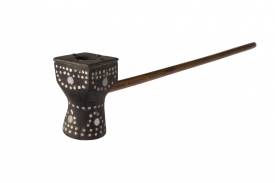TELDAP Collections
| Amis Pipe |
|
Traditionally, both men and women smoked pipes, and almost every tribe produced pipes of similar features. The largest difference was in the carved decorations. Pipe smoking was a habit among the Amis, Paiwan, Saisiyat and Atayal tribes. Pipes were smoked during times of rest and relaxation. Pairs or groups of men or women might be engaged in conversation while puffing away at their pipes! Pipes were made from bamboo that was common to Taiwan’s mountain areas and thus easy to obtain. The root of the bamboo was most often used. Annual bamboo of suitable thickness was the best for producing pipes.
There were some minor variations among the pipes used by men and women. The pipes used by men tended to be shorter and the head of the pipe tended to be larger and thicker. Often a bamboo root with a raised section was used. The pipes used by women were longer and thinner and smooth sections of bamboo root were used. The Paiwan preferred to carve patterns on the outside of their pipes. This was done to produce a personal mark or to show off carving skills, as well as to make the pipe more esthetically pleasing. The Amis often decorated their pipes with brightly colored tassels. The tubular part of the pipe was made from thin bamboo. In addition to serving as an important component of the pipe, this tube was also used by Atayal and Saisiyat shamans in healing ceremonies. Tobacco was grown in indigenous villages. Once harvested it was dried until the leaves became brittle. This allowed them to be easily crumbled into small pieces suited for pipe smoking. Usually men and women kept a pouch of tobacco leaves at their waists, so that they could easily add more to their pipes. When going out, men preferred to place their smoking paraphernalia in a pouch made of the skin of the mountain goat or the Formosan sambar. Women tended to wear their pipes in their hair. In the past, pipes were usually made by the persons who used them and lasted for about three or four months. To increase durability, sometimes a piece of metal was wrapped around the part where the tobacco leaves were placed to prevent the bamboo from overheating and breaking. This is an example of a pipe of the Amis tribe. It measures 20 centimeters in length, 3.5 centimeters in height at its tallest point and 2 centimeters in width. It was formed with a round base topped with a more boxlike section. Small round shells were used as decoration revealing the marine aspects of Amis culture.
Department of Graphic Communications and Digital Publishing, Shih Hsin University Digital archiving project of the Shung Ye Museum of Formosan Aborigines
|














